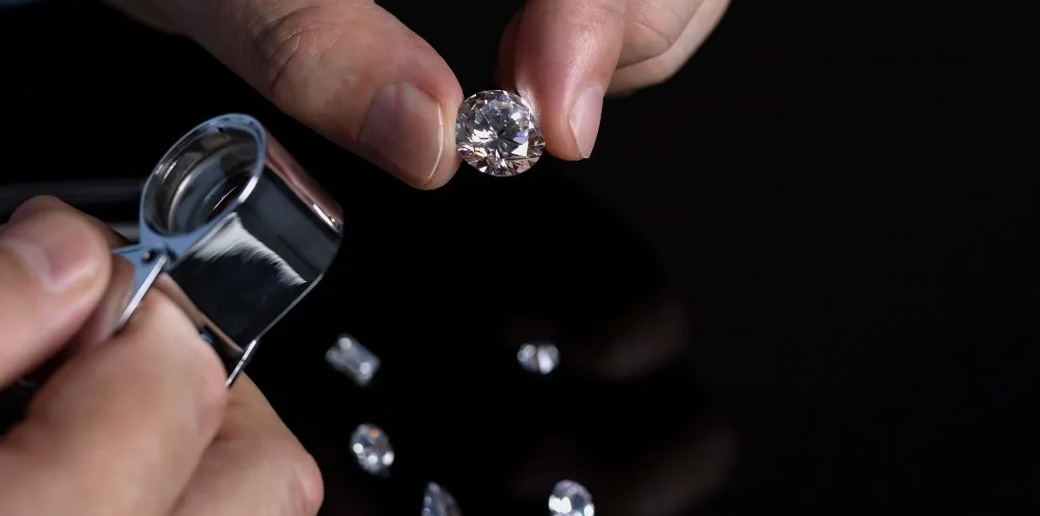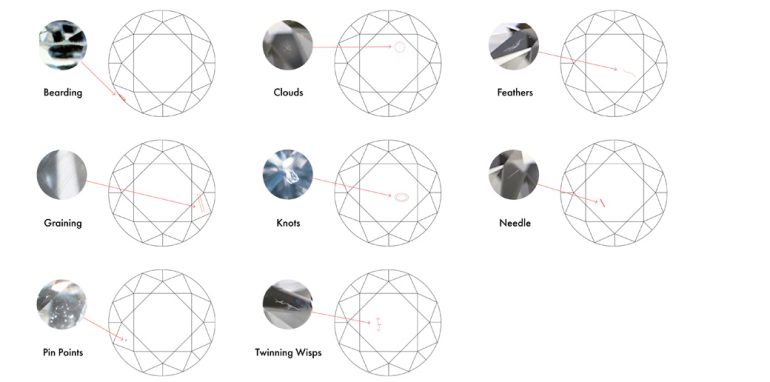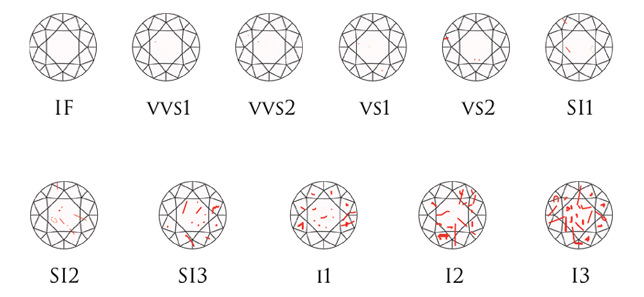Clarity is one of the four Cs of diamond and gemstone evaluation, alongside cut, color, and carat. All these natural stones reveal clues about their formation process, which typically involves minor internal features.
Clarity assessment focuses on the size, number, and position of these features when examined under a specialized magnifying lens. This means that diamonds and gemstones without visible inclusions to the naked eye are considered of excellent quality.
What is clarity?
Clarity refers to the purity of diamonds and gemstones. The clarity grade of a stone indicates the relative absence of inclusions (materials inside the stone), fractures, and blemishes (surface imperfections) that affect its appearance and structural integrity. Opaque and translucent stones have slightly different clarity standards compared to transparent ones.
Of course, there are other factors that can influence the appearance and structure of a stone, with cut being the most notable among them. However, clarity pertains to factors that are integral to the physical composition of the stone itself.
What are imperfections?
Due to their formation process under extreme temperatures and pressures, diamonds and gemstones often exhibit internal and/or external imperfections. These imperfections help gemology experts distinguish between natural stones, lab-grown ones, and simulants. There are two types of imperfections considered when evaluating clarity: inclusions and blemishes.
To assess the clarity of a diamond or a gemstone, it is necessary to observe the number and nature of the stone’s internal and external imperfections, as well as their size and position. The difference lies in their location: inclusions are enclosed within the stone, while blemishes are on the surface.
Inclusions refer to any foreign material present within the stone, such as minerals, internal fractures, feathers, tiny pinpoint inclusions (clouds), chips, granules, and other organic materials. The number, size, type, and color of inclusions determine the clarity grade of a stone. Some natural stones have no visible inclusions, while others can have many visible inclusions, which is why it’s essential to consult experts before making a decision.
Blemishes refer to any surface irregularities, including burns, cavities, additional facets, external granules, grinding lines, scratches, and chips caused by handling or cutting the stone during the polishing process.
How is the clarity grade measured?
The GIA system comprises 11 grades, and to determine a clarity grade, aspects such as size, nature, position, orientation, or color, as well as the quantity of visible clarity characteristics under a 10x magnifying lens, are considered. Thus, we have:
- Flawless (FL) – no inclusions or imperfections visible to a skilled evaluator using a 10x magnifying lens.
- Internally Flawless (IF) – no inclusions, only minor external imperfections visible under a 10x magnifying lens.
- Very, Very Slightly Included (VVS1 and VVS2) – inclusions are difficult to see under a 10x magnifying lens.
- Very Slightly Included (VS1 and VS2) – inclusions are minor and range from difficult to fairly easy for an expert evaluator to see under a 10x magnifying lens.
- Slightly Included (SI1 and SI2) – inclusions are visible under a 10x magnifying lens.
- Included (I1, I2, and I3) – inclusions are evident under a 10x magnifying lens and may affect transparency and brilliance.
Only diamonds can achieve FL and IF clarity grades, while all other grades are used for colored gemstones. Similar to the color scale, the GIA clarity grading system was developed because jewelers used terms that could be misinterpreted, such as “eye-clean” or “piqué.” Today, terms like the ones mentioned above refer to the same clarity grade worldwide.
Cabochon-shaped gemstones that exhibit optical phenomena like asterism are evaluated separately from faceted gemstones. The clarity grade for these types of stones is described as:
- Transparent – stones that transmit light without significant diffusion and may have inclusions like rutile or others.
- Translucent – stones that allow partial light transmission.
- Opaque – stones that do not allow any light transmission.
Types of Clarity
Some gemstones naturally have fewer inclusions than others, and besides the grade-based system, GIA has identified three types of gemstone clarity:
- Type 1 (Visually Clean) – means inclusions cannot be seen with the naked eye. Gemstones from the beryl family, such as heliodor, aquamarine, and morganite, fall into this category.
- Type 2 (Usually Included) – means gemstones can have visible inclusions. This category includes amethyst, andalusite, alexandrite, garnet, and peridot, among others.
- Type 3 (Almost Always Included) – means these gemstones almost always have inclusions, which may or may not add or detract from their value. Prominent examples in this category include green emerald, various types of tourmaline (especially blue), or rubellite.
So, the clarity of diamonds and gemstones is an essential aspect of their evaluation. While each stone has its uniqueness with specific inclusions and characteristics, assessing and identifying these imperfections can make a significant difference in their true value. AGL Gems, with its experienced and accredited team of experts, brings a professional approach and state-of-the-art technology, providing precise expertise and detailed gemological reports regarding the clarity of a diamond or precious stone.



